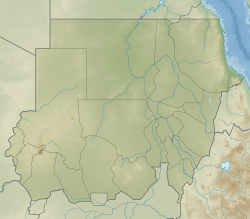| Shendi Formation | |
|---|---|
| Stratigraphic range: Maastrichtian ~ | |
| Type | Geological formation |
| Sub-units | Umm Ali & Kabushiya members |
| Underlies | Hudi Chert |
| Overlies | Precambrian basement |
| Thickness | 63 m (207 ft) |
| Lithology | |
| Primary | Sandstone |
| Other | Siltstone, mudstone |
| Location | |
| Coordinates | 16°42′N33°24′E / 16.7°N 33.4°E |
| Region | River Nile State |
| Country | Sudan |
| Extent | Atbara-Shendi Basin |
| Type section | |
| Named for | Shendi |
The Shendi Formation is a Late Cretaceous geologic formation of the Atbara-Shendi Basin in northern Sudan. [1] Indeterminate theropod remains have been recovered from it. [2] As well as those of the dyrosaurid Hyposaurus . It consists of a lower unit of fine grained meandering channel sediments, separated by an erosive contact with overlying meandering to braided river channel sandstones. [3]
Contents
The formation overlies Precambrian basement and is overlain by the Hudi Chert. [1] The total thickness of the formation amounts to 63 metres (207 ft). [4]
